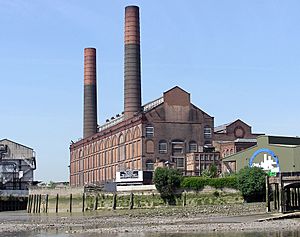Lots Road Power Station facts for kids
Quick facts for kids Lots Road Power Station |
|
|---|---|

Lots Road Power Station from the River Thames
|
|
| Country | England |
| Location | Royal Borough of Kensington & Chelsea, Greater London |
| Coordinates | 51°28′40″N 0°10′53″W / 51.47785°N 0.18127°W |
| Commission date | 1905 |
| Decommission date | 2002 |
| grid reference TQ264770 | |
Lots Road Power Station was a large power station in Chelsea, London. It was built next to the River Thames. This station made electricity for the London Underground (Tube) system. It first used coal, then oil, and later natural gas to create power. Some people mistakenly call it Fulham Power Station. However, Fulham Power Station was a different building about a mile away.
Contents
History of Lots Road Power Station
Plans for a power station at Lots Road began in 1897. The Brompton & Piccadilly Circus Railway first thought of building it. This railway is now part of the Piccadilly line. In 1901, a company led by Charles Yerkes took over the project. They built the station to power the District line trains. This allowed the District line to switch from using steam engines to electric trains.
The station was built on the north bank of the Chelsea Creek. Construction started in 1902 and finished in 1904. It began working on February 1, 1905. The station used to burn about 700 tonnes of coal every day. It could produce 50,000 kilowatts of power. At the time, it was said to be the biggest power station ever built. It ended up powering most of the Tube railways and tramways.
Station Upgrades and Changes
Lots Road Power Station was updated many times. In the 1920s, new systems were added to handle fuel more easily. In the 1960s, the station was changed to use heavy fuel oil instead of coal. Its electricity frequency was also updated. The number of tall chimneys was reduced from four to two.
Between 1974 and 1977, the boilers were changed again. They could now burn natural gas, which was found in the North Sea. It could still use oil if needed. Later, Lots Road worked with Greenwich Power Station. Together, they supplied power to the entire London Underground network.
Lots Road and Radio Broadcasting
The power station also played a part in early commercial radio in the UK. In October 1973, the first two commercial radio stations, LBC and Capital Radio, opened. Their main transmitter site was not ready yet. So, a temporary antenna was set up between the two chimneys at Lots Road. It broadcast LBC and Capital Radio until 1975.
The site was used again from 1979 for other radio broadcasts. This included a low-power relay for BBC Radio 4. It was used until 2001 when the transmitter moved. Other experimental traffic information and radio stations also broadcast from here.
End of Electricity Generation
In 1992, it was decided not to upgrade Lots Road Power Station again. It would continue to run until its machinery wore out. On October 21, 2002, the Transport Minister, John Spellar, officially turned off the turbines. This ended 97 years of making electricity at Lots Road. Since 2002, all power for the Tube system comes from the National Grid.
Redevelopment of the Site
In 1999, the land where the power station stood was sold. The new owners wanted to turn the power station into shops, restaurants, and apartments. They also planned to build new buildings, including two tall skyscrapers, on nearby empty land.
The project faced delays because the Kensington & Chelsea Council did not approve one of the towers. However, the other tower, called South Tower, was approved. The developer wanted permission for both towers before starting. In 2006, the government approved the full development plan.
New Plans and Construction
In 2010, Thames Water announced plans for the Thames Tideway super sewer. One of the access points for this sewer is near the Lots Road site.
On September 26, 2013, construction officially began. The developer renamed the area "Chelsea Waterfront." The Mayor of London, Boris Johnson, spoke at the ceremony. He called it the biggest riverside development on the north bank of the Thames in over 100 years. The project aimed to create 706 new homes.
The first part of the project, with 100 apartments, was finished by 2016. The second part, which included the power station building itself, was completed by 2018.
See also
- Power House, Chiswick – an earlier power station that Lots Road replaced
- Greenwich Power Station – another power station for the London Underground

